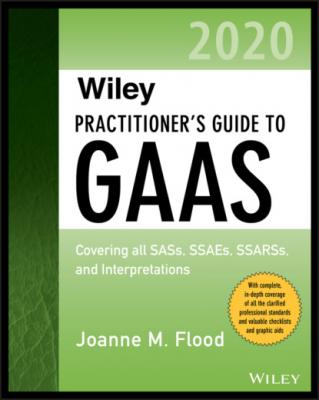Wiley Practitioner's Guide to GAAS 2020. Joanne M. Flood
Читать онлайн.| Название | Wiley Practitioner's Guide to GAAS 2020 |
|---|---|
| Автор произведения | Joanne M. Flood |
| Жанр | Бухучет, налогообложение, аудит |
| Серия | |
| Издательство | Бухучет, налогообложение, аудит |
| Год выпуска | 0 |
| isbn | 9781119596035 |
Tolerance of petty theft.
Illustration 3. Worksheet to Identify Fraudulent Entries or Adjustments (Adapted from Au-C 240.49)
Inappropriate journal entries and other adjustments often have certain unique characteristics. The auditor should use the following questions to help identify characteristics of inappropriate journal entries and other adjustments:
Is the entry made to an unrelated, unusual, or seldom-used account?
Is the entry made by an individual who typically does not make journal entries?
Is the entry made at closing of the period or postclosing with little or no explanation or description?
Do entries made during the preparation of financial statements lack account numbers?
Does the entry contain round numbers or a consistent ending number?
The auditor should use the following questions to identify journal entries and adjustments made to accounts that have the following characteristics:
Does the account consist of transactions that are complex or unusual in nature?
Does the account contain significant estimates and period-end adjustments?
Has the account been prone to errors in the past?
Has the account not been regularly reconciled on a timely basis?
Does the account contain unreconciled differences?
Does the account contain intercompany transactions?
Is the account otherwise associated with an identified risk of material misstatement due to fraud?
Illustration 4. List of Circumstances That May Indicate the Possibility of Fraud (from Au-C 240 Appendix C)
Conditions may be identified during fieldwork that change or support a judgment regarding the assessment of the risks, such as the following:
Discrepancies in the accounting records, including:Transactions that are not recorded in a complete or timely manner or are improperly recorded as to amount, accounting period, classification, or entity policy.Unsupported or unauthorized balances or transactions.Last-minute adjustments that significantly affect financial results.Evidence of employees’ access to systems and records inconsistent with that necessary to perform their authorized duties.Tips or complaints to the auditor about alleged fraud.
Conflicting or missing evidential matter, including:Missing documents.Documents that appear to have been altered.Unavailability of other than photocopies or electronically transmitted documents when documents in original form are expected to exist.Significant unexplained items on reconciliations.Unusual balance sheet changes, or changes in trends or important financial statement ratios or relationships; for example, receivables growing faster than revenues.Inconsistent, vague, or implausible responses from management or employees arising from inquiries procedures.Unusual discrepancies between the entity’s records and confirmation replies.Large numbers of credit entries and other adjustments made to accounts receivable records.Unexplained or inadequately explained differences between the accounts receivable subledger and the control account, or between the customer statements and the accounts receivable subledger.Missing inventory or physical assets of significant magnitude.Unavailable or missing electronic evidence, inconsistent with the entity’s record retention practices or policies.Fewer responses to confirmations than anticipated or a greater number of responses than anticipated.Inability to produce evidence of key systems development and program change testing and implementation activities for current-year system changes and deployments.
Problematic or unusual relationships between the auditor and management, including:Denial of access to records, facilities, certain employees, customers, vendors, or others from whom audit evidence might be sought.Undue time pressures imposed by management to resolve complex or contentious issues.Complaints by management about the conduct of the audit or management intimidation of audit team members, particularly in connection with the auditor’s critical assessment of audit evidence or in the resolution of potential disagreements with management.Unusual delays by the entity in providing requested information.Unwillingness to facilitate auditor access to key electronic files for testing through the use of computer-assisted audit techniques.Denial of access to key IT operations staff and facilities, including security, operations, and systems development personnel.An unwillingness to add or revise disclosures in the financial statements to make them more complete and transparent.An unwillingness to address identified deficiencies in internal control on a timely basis.
Illustration 5. Example Program for Management Override of Internal Control
|
Page |
|
| Company: | Balance Sheet Date: |
| Audit Objective | Audit Procedure for Consideration | N/A Performed By | Workpaper Index |
| AUDIT OBJECTIVESTo identify risk of material misstatement due to fraud caused by inappropriate or unauthorized journal entriesTo determine whether management is not unduly biased in the preparation of significant accounting estimatesTo determine whether significant unusual transactions have not been entered in order to engage in fraudulent financial reporting or to manipulate earnings. | |||
| A. | Review of Journal EntriesObtain an understanding of the company’s financial reporting process and the controls over nonstandard journal entries. Document the following:The sources of entries posted to the general ledger (for example, subledgers, cash receipts journal, etc.)How the journal entries are recorded and whether physical documentation existsThe individuals responsible for: (a) initiating, (b) reviewing, and (c) approving the journal entriesThe controls in place to prevent and detect unauthorized entries | ||
| A. | Obtain an understanding of the adjustments posted by the entity to prepare its financial statements (for example, reclassification or consolidating entries). Document the following:The nature of the adjustments posted to the financial statements that are not posted to the general ledgerHow the adjustments are posted to the financial statementsThe individuals responsible for: (a) initiating, (b) reviewing, and (c) approving the adjustmentsThe controls in place to prevent and detect unauthorized adjustments | ||
| A. |
Identify and select significant nonstandard journal entries and other significant adjustments for testing. In making this selection, consider the following:The effectiveness of the company’s controls over journal entries and adjustmentsThe characteristics of fraudulent entries or adjustments, such as:Made to unrelated,
|
